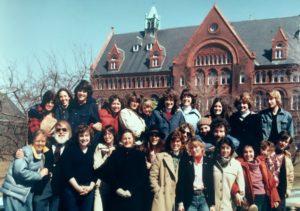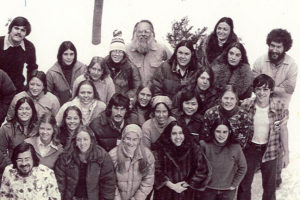
Abandon the notion of subject-matter as something fixed and ready-made in itself, outside the child’s experience; cease thinking of the child’s experience as also something hard and fast; see it as something fluent, embryonic, vital; and we realize that the child and the curriculum are simply two limits which define a single process. Just as two points define a straight line, so the present standpoint of the child and the facets and truths of studies define instruction. It is continuous reconstruction, moving from the child’s present experience out into that represented by the organized bodies of truth we call studies (Dewey, p11).
The implication for the future of American public schools was that “unless students could be reawakened to their personal power in pursuing self-directed studies, then there was little hope that they in turn would kindle a like spirit in the hearts and minds and bodies of young school children.” The idea that every human being needs to be a self-directed learner capable of making independent and sound choices over a lifetime was a fundamental philosophical premise (of the Apex program). (Holmes, p30).
Student learning in the APEX program is characterized by interaction in small groups, freedom to make important educational choices, exposure to curricular content through an integrated set of experiences, and evaluation in terms of defined areas of competence and performance. However, the most pervasive learning characteristic stems from the “principle of direct experience” (Holmes, p35).
What’s an Apex?
Apex was love. Apex was dedication. Apex was engagement. Apex was about finding out who you were. Apex was about connection. Apex was about mattering. For most of sixteen years at UVM, Frank Watson and I, with the help of 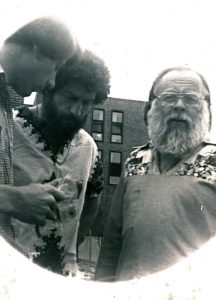 many colleagues, ran a primary grades specialization program in elementary teacher education. That program was APEX. The American Primary Experience Program, a name deliberately chosen to mirror the phrase, British Primary Schools. My experience in APEX paralleled my work with multiage, or as Lady Plowden would have said, family grouped classrooms.
many colleagues, ran a primary grades specialization program in elementary teacher education. That program was APEX. The American Primary Experience Program, a name deliberately chosen to mirror the phrase, British Primary Schools. My experience in APEX paralleled my work with multiage, or as Lady Plowden would have said, family grouped classrooms.
Apex started because Dean Corrigan said, “Do it.” Apex was born the day he erased from a portable office chalkboard one of two new program possibilities during a college planning meeting in his office. The possibility that was left was us. With chalk dust fresh in the air, two possibilities became one reality. Frank and I looked at each other, grinned, and said, “Let’s go!”
Multiage classrooms were on the rise in Vermont. I believed UVM needed a teacher education program that emulated the successful practices of the British Infant Schools. Fledgling teachers needed to be taught how to teach in those very child-centered ways. Conventional teacher education courses were not about preparing students to teach in active, child centered, interest driven rooms filled with children of heterogeneous learning abilities. Learning about how children learn was relegated to a course, not a program. It would do no good to read others’ stories about how these classrooms worked. We needed to follow Dewey’s example in The Child and The Curriculum and integrate learning theory (child study) and school curriculum (subject matter study) into a way of teaching that included subject matter AND child study. And we needed to do this work in schools with real children as much as we could so that feedback about our efforts was authentic and personal and direct and real. Right from the source. We would all become inquirers about how our work “worked.”
A few vignettes to illuminate the program and how it worked.
Context – the students and the learning space
Twenty-one third year students sit in a circle facing each other. The room is our teaching room, just off our suite of offices in UVM’s newly opened Living Learning Center. A large loft dominates a corner of the room, space for two or three students to sit and read above, pillow space below. The loft is constructed of discarded barn rafters and grayish barn wood. The cinder block wall on the door side of the room shines with the mural of a stream, a giant tree, and a warm, red-orangy yellow sun shining down on us all. The entryways to a small laundry and a kitchenette dominate the third wall of the room and the fourth wall of the room has large windows and a doorway to the outside lawn.
First vignette: The students bring forward a proposal
The student group is typified most by longish and straight hair, flannel shirts, a variety of Birkenstocks or L. L. Bean boots, and denim jeans, skirts, shirts, whatever. Three of the students have brought their dogs with them and over these early days of the semester, the dogs have finally become comfortable with each other. Our space feels crowded when we are arranged as we are. But the circle is important. Everyone has to have an equal say in the decisions we make and the circle emphasizes the equality of relationships and responsibilities we are trying to promote. The group has a laid back intensity as it digs into the same discussion we’ve been having during our afternoon meeting time for over three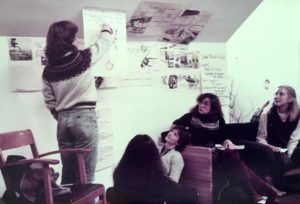 days now. This is the fourth day, and our eighth classroom meeting. We’re reading William Glasser’s Schools Without Failure and Rudolf Dreikurs’ Maintaining Sanity in the Classroom as we learn how to do these problem solving meetings.
days now. This is the fourth day, and our eighth classroom meeting. We’re reading William Glasser’s Schools Without Failure and Rudolf Dreikurs’ Maintaining Sanity in the Classroom as we learn how to do these problem solving meetings.
Dawn speaks. She’s a bit older. She’s done alternative service before coming into Apex, and she understands how to use power better than most students in the circle. It probably doesn’t hurt that she’s grown up around power discussions. Her Dad is President of the University. She begins.
“Yesterday, we finally got serious on this grading issue. We clarified with Frank and Charlie that this discussion is about influence, not just input. If they are serious about wanting to share the responsibility for grading our courses with us, then we have to be clear about what we want. What I’ve got here is a grading proposal that several of us worked on last night. I want to read it and get your feedback on it.”
The document she distributes proposes that every course taught within Apex be graded on a Pass/Fail basis. And though the document stops short of recommending that students assign their own grades, students have significant input into the grading process. Frank and I had been thinking about the power relationships that grading sets up when professors design course requirements, grading criteria, and then go ahead and award grades based on their own assessment of student work. It seemed to us that were we to go down the usual university route with the students in this unusual program, then we would be eliminating one more necessity for students to have to think about what they wanted to accomplish, how they wanted to accomplish it, and on what basis they wanted to hold themselves accountable for both the quality and quantity of their work. It seemed to us that these were important issues for teachers-to-be to consider, and once more, they were important issues for teachers to have their students of whatever age consider. What better way to prepare teachers to deal with this complicated relationship between content expertise, individual ownership, and locus of control than to give our students the power to work a policy change. We told them we’d do whatever we could to support their decision. We could not promise that we’d be successful. We could only promise we’d try.
Carrie speaks. “Dawn, I really appreciate the work that you and Doug and Jim and Susie have done here. It’s an amazing piece of work. But I’m worried about the issue of getting a job or going on to graduate school.” Carrie’s face mirrors concern. Her straight black hair sweeps down around an almost angelic face. She is a deep thinker and the idea of moving to a P/F grading scheme has her struggling with a side of her she didn’t know so well. In my office yesterday, she talked about how she’d always led her life to do the right things. Carrie was a devout Christian and she was quite open about her love of Christ and His way. She liked the freedom and responsibility that was promoted by upcoming proposal, but she was deeply worried that what she might do would not be somehow acceptable. This whole discussion had opened her eyes to just how dependent she was on other systems of authority for her own personal confirmation and she wasn’t so sure she liked that. On the other hand, she wanted to go on with her study after Apex. She wanted to be trained as a speech pathologist and she was worried that graduate schools would consider her a graduate of a flakey program with all those passing grades on her transcript. She worried that we were making a decision that would disadvantage her for her next round of education. “How can we do what we think is right here and not hurt ourselves if we want to go on for more education? How can we know that principals won’t pass us over if they don’t see and “A” under student teaching? How can we be sure?”
What the group was realizing, of course, is that they were moving to a place of uncertainty about the effect of present action on future employability. The principals they’d talked to were split on the issue of grades vs. pass/fail. Some said they didn’t care about grades at all. They wanted to see what a person could do. Others said they used grades as a first cut through the piles of resumes they received. This was a complex issue with many sides to it.
Vignette Number Two: The Apex Paper Airplane Contest
We were way too rowdy. Several times, people had stopped by to watch and laugh with us. I bet if we had run a betting booth, we’d have done quite well. It was the annual Apex Paper Airplane Extravaganza. Six teams of four students spent the morning reading about Bernoulli’s principle, studying different paper airplane designs, thinking about lift and drag, and designing and testing their own candidates for the Plane Of The Day Award. Each team had to come up with one airplane, one plane, ready to go, one plane ready to be judged in three different categories: aesthetics, time aloft, and distance traveled. The planes had to be made of paper, no tape or paper clips or other accoutrements could be added to them. This was to be pure paper, pure design, pure fun. And good enough science.
We trekked to C-Building of Living Learning Center. As usual, whenever we did one of these whole-group participatory learning experiences, we were not calm about it. We attracted lots of attention. Hank was elected MC. MC Hank. He got the group organized as best he could. Richie was more excited than usual. His very red face made me wonder if he’d been engaged in pursuits beyond paper airplane construction but he wasn’t hurting anyone and was in fact really into the task at hand. Sarah had taken over her group. She’d just put Richie in his place, as a matter of fact, when he tried to move forward of the start line. We had two-person measurement and timer teams (accomplishing an introduction to “what is an average” at the same time), and faculty were asked to serve as arbiters of “aesthetics.” Posters covered the walls boasting the prowess of certain airplanes. This evidenced a recent study of writing genres, in this case a transformation of persuasive essaying into persuasive visual advertising. Most likely, the circus posters triggered the advertising. They remained on the wall, the last remnant of the circus performance we’d done the month before.
When it was Sarah’s turn, she effortlessly lays her group’s airplane out onto the air. She releases it with a delicate flick of her first three fingers. Such a gentle move. The delta wing entry takes off as if it has a life of its own. It actually rises as if to catch a current and then slowly descends. It’s a real question whether or not it will hit the far wall before finishing its flight. Some in the group stand transfixed, gaping at the almost alive flight. Others hoot and holler as if to add their air to its lofting, or cause it to come crashing down on the turbulence of the sound – depending on your orientation to “team.” It is a somewhat magical moment in a jam-packed day. I look at Frank and he looks at me. We are both frustrated and fine about these passing moments. The silent thoughts that pass between us are one and the same. How are we to going to milk this experience for all its worth? Like much that we do, there is good science content here, there are lessons to be learned in the interpersonal dynamics, and taking apart the organization of this sixty-minute activity is a class in itself. To say nothing about how to assess these direct, hands-on, student-centered experiences. We’ve kept good data on the flight aspects of the activity. Will we have time to bring it back to Bernoulli? Can we spend some moments listing all the different abilities were needed for each group to do this flight activity well? We could take tomorrow, advance what we’d planned for that day, and spend the day deconstructing this contest. We could do that. But we’ve done that way too much already this semester and the days left are far fewer than all the good ideas we have left to 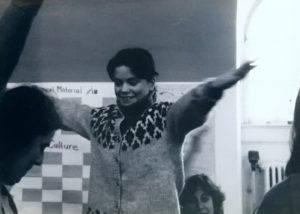 bring forward. Sarah stands there, the backs of her hands on her hips, head tilted, adding the last little bit of body English to ease the plane’s decent. She then turns to no one in particular and says, “See? Who says girls don’t know anything about flight? I guess we showed ‘em.” People laugh at her and with her. Sarah’s plane finally slows enough to lose lift and ungraciously plops to the floor. People applaud. The measurement and timer teams get on with their work, do their calculations, and announce a new leader in both categories, for the moment anyway. We have several more to go.
bring forward. Sarah stands there, the backs of her hands on her hips, head tilted, adding the last little bit of body English to ease the plane’s decent. She then turns to no one in particular and says, “See? Who says girls don’t know anything about flight? I guess we showed ‘em.” People laugh at her and with her. Sarah’s plane finally slows enough to lose lift and ungraciously plops to the floor. People applaud. The measurement and timer teams get on with their work, do their calculations, and announce a new leader in both categories, for the moment anyway. We have several more to go.
Vignette Number Three: Laying groundwork for a culminating experience
We are at Frank’s house, again. It has been a snowy afternoon. Most of the students have made it out to Poker Hill Road, most of them have brought their skis, and all have had a delightful time away from UVM. Frank and Anne’s property is cross-country heaven. Joe Abruscato, another staff 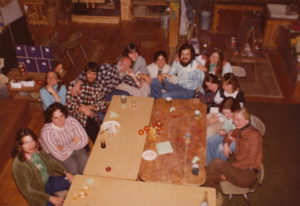 member, cooks his famous sausage and peppers. Frank has made a soup, and I’ve brought a lasagna. Others have gone in on soups, dips, breads, bean dishes, and assorted sweets. There’s no lack of food, that’s for sure. Frank has the fireplace warming us all. His wife Anne move easily through the crowded room saying “Hello” to many students by name. She’s done work on the writing process with us this semester.
member, cooks his famous sausage and peppers. Frank has made a soup, and I’ve brought a lasagna. Others have gone in on soups, dips, breads, bean dishes, and assorted sweets. There’s no lack of food, that’s for sure. Frank has the fireplace warming us all. His wife Anne move easily through the crowded room saying “Hello” to many students by name. She’s done work on the writing process with us this semester.
Besides an afternoon away from Burlington, the purpose of our getting together is to plan the outlines of next semester’s work. There has been talk of wanting to leave campus to spend a week or two working with teachers and children in the far North of Vermont, a small elementary school in Berkshire, VT. We’ve heard through a teacher contact that some of the faculty from Berkshire would “just love to have some students come and spend time with their students”. They also could use some assistance designing and constructing a nature trail through the woods behind their school. Would we be interested? This evening is to lay out preliminary plans for how we might go about this. We’ve done it before. We face a lot of work. Ann, a different Ann, an Apex student in her final semester at UVM, has taken on some of the responsibility to get this organized. With a bit of help from some of her peers, she’s visited the school, talked with the principal, Ray, and had discussions with some of the teachers. As is usual in these situations, some teachers will be overjoyed to have us come; others will see us as an annoying intrusion. Frank’s living room feels way too warm to do any serious planning and people are worn out from the afternoon’s exertions but we rouse ourselves as Ann begins to lay out the possibilities. “Berkshire is a small school. Ray is very nice and very helpful and he really wants this to happen. We talked and he thinks he has maybe six teachers who would work with us. He introduced me to Tom. He’s the sixth grade science teacher whose idea the nature trail is. We looked at the probable site. He knows where he wants it to go but there’s trailwork that must be done. It’s wet in some areas. It needs some logged  footpaths and perhaps even a bridge over one portion of the stream. And Ray isn’t sure he has enough teachers for all of us. We may have to think about another school, like Enosburg, maybe. This is getting a little more than I can handle. I need some help.” Frank sits there next to the fire, cross-legged, rubbing his bearded chin, head tilted back, listening. He never says, “No.” I honestly wonder what he’s going to say about this one. We control all our student’s education coursework time but they still have to take courses in the larger university. Our university colleagues are a varied lot when it comes to understanding why students might miss a few classes. Especially non-athletes. Education students? Why would you be going to Berkshire for two weeks? Of course you shouldn’t be absent from class.
footpaths and perhaps even a bridge over one portion of the stream. And Ray isn’t sure he has enough teachers for all of us. We may have to think about another school, like Enosburg, maybe. This is getting a little more than I can handle. I need some help.” Frank sits there next to the fire, cross-legged, rubbing his bearded chin, head tilted back, listening. He never says, “No.” I honestly wonder what he’s going to say about this one. We control all our student’s education coursework time but they still have to take courses in the larger university. Our university colleagues are a varied lot when it comes to understanding why students might miss a few classes. Especially non-athletes. Education students? Why would you be going to Berkshire for two weeks? Of course you shouldn’t be absent from class.
These special projects take a lot of work. Do we really want to take another one on? Yet we learn so much. The project itself make such a positive contribution to the community. They enable our students to see how field trips and big projects and community service is really done. But my, it’s a huge effort. And we do it all ourselves. Our leaders (Dean, Department Chair, Associate Dean) come at the end for the proverbial, “Good job well done,” but only at the end. The students are listening thoughtfully though and asking good questions. “What if we get with a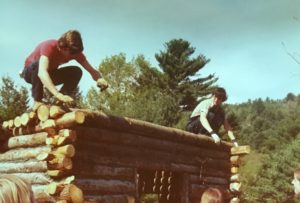 teacher who doesn’t want us?” “Where will we stay?” “Does anyone know a place we could stay?” (The answer is yes.) What about our other classes? What are the kids like? Who knows how to build a bridge, use a chain saw, cook soup for twelve, and on it goes. Frank smiles that smile. Looks like we are going to Berkshire.
teacher who doesn’t want us?” “Where will we stay?” “Does anyone know a place we could stay?” (The answer is yes.) What about our other classes? What are the kids like? Who knows how to build a bridge, use a chain saw, cook soup for twelve, and on it goes. Frank smiles that smile. Looks like we are going to Berkshire.
Vignette Number Four: Problem-solving the human dramas of working in schools
Kim, always with a keen sense of drama, is pissed. “I think she hates me!” she wails, through tears pressed from her blood-shot eyes. “I just can’t seem to do anything right in there. It is a tough group of kids. First of all there’s such a span of ages, and then those two boys just won’t let each other alone, and then they get everyone else riled up. I can’t get Sally to stop talking for one minute and they just seen to take advantage of me when I get nice with them. This is crap!” Kim is having a hard time in a very complex room. It is the fourth week of the semester and she feels like she’s out of control. What I know is that she is bright, quick, intuitive, and unplanned. I also know she is out of control! Marilyn, her master teacher, knows this, too. Marilyn has worked with us for four years now. She’s had third year students and fourth year students. She’s an expert at gradually releasing responsibility to our student teachers. But Kim is not rising to the occasion and Marilyn is beyond frustration now. She’s angry. She called me during her thirty-minute lunch “break” today and said something had to give here. She’s angry at Kim and she’s angry at us. Kim is falling apart and Marilyn has little slack left in her rope. We’ve got to get Kim to slow down and begin to plan ahead so that she can strategize about what to do with the individual students who are taking her for a ride. “Kim,” I say. “Look at me. Listen to me now.” She turns to face me. We are both standing in my office with the door shut. She looks at me, big freckles on her face. She hates them. Her heavy straight black hair is bobbed ear length. She’s an old teenager living the life of a young adult and it’s showing. “I know you are under all kinds of pressure. Your Mom, your history in the school, the fact that you live in that community, your job; but you’ve got to get hold of yourself. You’ve got to get your feet on the ground. You can do this. You can deal with the complexity of this classroom. But you can’t do it with half-baked plans or no plans at all. You have to give it a chance. We’ll support you however we can. I’ll sit down with Marilyn. We can all sit down with Marilyn. But you’ve got to meet us half way. Maybe you shouldn’t be working so much? Are you sure you’re okay? You look totally, thoroughly, exhausted.” She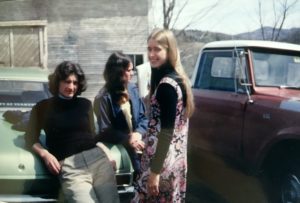 sinks into the chair and starts to cry all over again. Sobs shudder through her body. “I’m not sleeping. I work late. And I’m so fried at the end of work I can’t sleep so I go out and party and that’s the way I get tired. I drink. I drink way too much. (Marilyn has smelled alcohol on her breath.) I know it’s not doing me any good but I really need the money. I can’t stand feeling like this. I’m better than this. I know I can do this.” I tell her she has to quit her job. She has to get the money she needs from home or somewhere if she’s going to make this work. She’s one of our most talented students, she’s a leader in many ways, she’s intelligent and street smart when it comes to working with kids and she has the innate capacity to make any situation, difficult. But I know she can be a talented teacher for all kinds of kids and I’ll do whatever it takes to help her get there. But she must prove she wants it. “Kim, you have to show me you want this thing. Otherwise I’m going to pull you. You aren’t doing anyone any favors right now, including yourself. It’s up to you. You decide. But if you don’t, if things stay the way they are, it’s over in a week! We’ve been down this road before. I’m not going there any more.” Her big dark eyes take in my every word. Her mascara has run all the way down her face and is dripping off her chin. I hand her a Kleenex, she wipes it off, we laugh a little at the mess. Almost a full minute goes by. We sit there looking at each other. “It’s that bad?” she asks. “Yes, it’s that bad.” “Wow. This is shit.” Another pause. I think she’s got it. I give her the weekend to take some initiative in the matter. We set up another meeting for Monday.
sinks into the chair and starts to cry all over again. Sobs shudder through her body. “I’m not sleeping. I work late. And I’m so fried at the end of work I can’t sleep so I go out and party and that’s the way I get tired. I drink. I drink way too much. (Marilyn has smelled alcohol on her breath.) I know it’s not doing me any good but I really need the money. I can’t stand feeling like this. I’m better than this. I know I can do this.” I tell her she has to quit her job. She has to get the money she needs from home or somewhere if she’s going to make this work. She’s one of our most talented students, she’s a leader in many ways, she’s intelligent and street smart when it comes to working with kids and she has the innate capacity to make any situation, difficult. But I know she can be a talented teacher for all kinds of kids and I’ll do whatever it takes to help her get there. But she must prove she wants it. “Kim, you have to show me you want this thing. Otherwise I’m going to pull you. You aren’t doing anyone any favors right now, including yourself. It’s up to you. You decide. But if you don’t, if things stay the way they are, it’s over in a week! We’ve been down this road before. I’m not going there any more.” Her big dark eyes take in my every word. Her mascara has run all the way down her face and is dripping off her chin. I hand her a Kleenex, she wipes it off, we laugh a little at the mess. Almost a full minute goes by. We sit there looking at each other. “It’s that bad?” she asks. “Yes, it’s that bad.” “Wow. This is shit.” Another pause. I think she’s got it. I give her the weekend to take some initiative in the matter. We set up another meeting for Monday.
Controlling time and space, keys to the kingdom
The smartest move we ever made in Apex was to gain total control over our students’ time. When we went to the faculty for a vote to approve the program, we went with a proposal that established our instructional responsibility for their total program, save one course. That single act meant we could chunk their course experiences into large instructional blocks of time. In doing this, we could do whatever we wanted to do within those blocks, most particularly in the junior year. This allowed us terrific flexibility in how we organized our two-year curriculum. Guided by the same developmentally focused, interest driven epistemology that supported Lady Plowden’s British Infant Schools, we were a  hands-on, minds-on, feelings-on program. We had fun and we had tears. But we developed deep and enduring relationships with our students, particularly in our first decade. Our curriculum was integrated, interdisciplinary, and complex to administer. It was reality tested in public school venues across the four semesters of the program. The Apexers had to figure out how they were going to attack our assignments through writing a self-directed learning plan organized around a group of categories we provided. These conversations around these plans were always rich, always challenging, always pregnant with possibility. It was the uncertainness whether or not an outcome could be achieved that motivated the intellectual inquiry into what should be taught, how, and with whom, and how the outcomes should be measured. It was how our students learned to problem solve and begin to get a handle on what they knew about content and what they were learning about teaching.
hands-on, minds-on, feelings-on program. We had fun and we had tears. But we developed deep and enduring relationships with our students, particularly in our first decade. Our curriculum was integrated, interdisciplinary, and complex to administer. It was reality tested in public school venues across the four semesters of the program. The Apexers had to figure out how they were going to attack our assignments through writing a self-directed learning plan organized around a group of categories we provided. These conversations around these plans were always rich, always challenging, always pregnant with possibility. It was the uncertainness whether or not an outcome could be achieved that motivated the intellectual inquiry into what should be taught, how, and with whom, and how the outcomes should be measured. It was how our students learned to problem solve and begin to get a handle on what they knew about content and what they were learning about teaching.
Real teachers, real children, real situations to learn from
We were determined to go to the kids in the schools. This meant we had to work with schools in partnership. We did not want a model that sent our students out while we stayed safely above the fray on our University Hill. When they were in schools, we were in schools. And therefore, we dealt constantly with the inherent inequities of site-based learning. Any teacher educator worth her/his salt will tell you the range of expertise and example present in public school placement sites is mind boggling. It is impossible to create equitable placements across any two or three settings. Because of this, we always run the risk of disadvantaging students who end up in placements that don’t work out, for whatever reason. Thus, any program worth its salt has to acknowledge this up front and deal with it head on, at least with your students. Granted, “Not working out” is a roundabout with at least four dynamics feeding into it: mentor teacher, university supervisor, the mix of students in the classroom, and the teacher-to-be.
Making placements work
Frank and I and our colleagues strategized to maximize the probability that placements would work out over time. Our strategy was a four front approach:
1) Between their first and last school placement, students worked in three different field sites. The range of placements ensured that no one placement defined success or failure.
2) We engaged the students in whole group conversations during their student teaching internship. This meant they saw their ups and downs collectively so they could “scale” different parts of their own experience. This lessened the chance that a student might conclude their placement was all good (or all bad).
3) We were in the schools a lot. We had lots of conversations with all the actors involved. We spent time in the classrooms, often interacting with the kids. We knew the settings. We were credible, for the most part, in our teacher’s eyes. This alone, though it took time and energy away from other necessary pursuits, anticipated crash and burn situations before they got out of control.
4) We worked hard to get the discussion in the seminars to a point where our students realized that resistance in the school was not about them, personally. This is incredibly hard to do when someone is staring their own definition of failure in the face, but we were quite successful in teaching our students to see 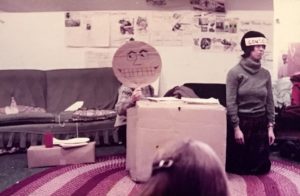 that they could manipulate the instructional and social systems in their rooms to their advantage. Like themselves, we wanted them to feel the central role emotions and social relationships play in organizing and maintaining a rich and effective learning environment. That was the message of the Paper Airplane Extravaganza. If kids are busy having a good time while they experience complicated things, they are less likely to want to do you in.
that they could manipulate the instructional and social systems in their rooms to their advantage. Like themselves, we wanted them to feel the central role emotions and social relationships play in organizing and maintaining a rich and effective learning environment. That was the message of the Paper Airplane Extravaganza. If kids are busy having a good time while they experience complicated things, they are less likely to want to do you in.
Personal Accountability
We were also successful because we pioneered a system of competency based performance assessment long before the profession popularized those words. The students did decide to adopt a P/NP form of grading. Amazingly enough, Frank and I and our Dean were able to get the proposal approved through the University system. When that happened, it became our responsibility to create some kind of tangible proof for what each of our students knew and could do. Yes, we even used that language before 1995. The official university transcript of each Apex graduate was stamped with a message that directed the reader to a supplemental program transcript. We expected each student to document and file – notebook or otherwise – evidence of what they knew and did cross-referenced across eight program competencies[i]. A tutoring session in writing, for example, might be address three or four competencies. By keeping track of how each competency was met, each student had one way to explain where their special strengths lay and everyone could see where they needed additional work. Professional growth did not end a grade of “A.” Further development and refinement was always possible and often necessary: reflection and revision was just a fact of life: personal and professional.
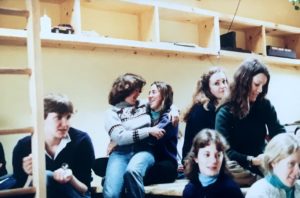
We were family. We were learning centered. We were experiential. We shared program responsibilities. And we grew trust and support with each other by learning how to create, maintain, and deepen personal relationships. We were accountable to each other, and we felt accountable to the students in the schools for what they taught us about how to teach so they could learn.
Twenty years after she graduated, an Apex graduate still teaching in Vermont schools reflected on what she gained from learning to teach in the Apex Program.
Apex gave me a belief in how to teach. A standard I hold myself to from student teaching on to today. I still hold myself to it even though these days I find myself falling short. Apex gave me a very well defined and intrinsically developed sense of what is good teaching and of the habit of reflecting on my teaching. Even now, I come to the end of a day and ask myself if I met that standard? Good teaching is experiential, it takes time, it is equitable because there are more opportunities for kids to learn and there are different ways kids should be able to learn and they need time to do it. The yardstick was all about student engagement and the tool for getting their constant reflection on my teaching with every kid in the classroom. This focus on learning was almost like a religion about what’s right for kids.
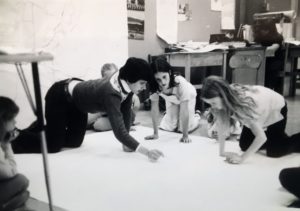
Apex in many ways, transferred the learning experience I’d received in my urban teaching to a university setting. Power, Identity, Connection. Their import was as applicable to my eighteen year olds as it was to my thirteen year olds. Maybe even more. I found my college students often drifting in their lives. They weren’t sure what they wanted to do with life after college. Traditional face-the-chalkboard classroom learning held little excitement or purpose for them. On the other hand, the activity and personal accountability of the program gave them things to do that they could believe in. Our work mattered. They learned that they themselves could be good enough (and in control of themselves enough) to make a difference in the learning lives of all kinds of public school children. Kim was a good example. She was unfocused, she thought she could do it all, she was bright and very able to succeed by virtue of her smarts and quick steps. But Apex gave her a complex reality she hadn’t experienced before. The wall she hit was real and the dilemma she faced was intensely personal. Kim, by the way, took a leave from her job, gathered her resources, got some sleep, and finished with Marilyn’s final approval.
Recognition, moving on
Apex won the most prestigious national teacher education award in 1976 – AACTE’s Distinguished Program Award (American Association of Colleges of 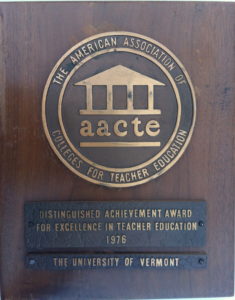 Teacher Education). One year later, Apex was recognized as one of three outstanding programs in the world by the International Association of Teacher Educators. The program ended twelve years later when Frank and I moved on to other pursuits, first I, and then Frank. Over the span of years the program was alive, we had ten effective and professionally expert university and public school colleagues join us as part or full time staff. When we decided it was time for a change for us, no one stepped up to the plate. Apex ended as it should have. And perhaps, it was even time.
Teacher Education). One year later, Apex was recognized as one of three outstanding programs in the world by the International Association of Teacher Educators. The program ended twelve years later when Frank and I moved on to other pursuits, first I, and then Frank. Over the span of years the program was alive, we had ten effective and professionally expert university and public school colleagues join us as part or full time staff. When we decided it was time for a change for us, no one stepped up to the plate. Apex ended as it should have. And perhaps, it was even time.
1. It got increasingly harder for us to mount culminating experiences because the schools were less flexible in how they ran their days.
2. The Standards movement coupled with graded assessments in the public schools severely constrained the opportunities for freedom and choice for students.
3. The number of multiage classrooms dropped precipitously as the schools cranked up their testing regimes in response to federal mandates. There were fewer and fewer quality placements for our students.
4. The program was wholly identified with Frank and I. The faculty in the Teaching and Learning Specialties area claimed it as their own and no one could really move into our roles.
For a time, though, I’m convinced we were able to pursue learning the way it should be pursued for older students who want to teach so younger students can learn, and want to learn.
*****


Frank and I could not have managed this program by ourselves alone. Here are some of our University colleagues who helped us be successful:
Faculty = Marge Lipson, Marty Garrett, Joseph Abruscato, Donald Hilman, Chris Stevenson, Mark Smith.
Graduate Students = Paul Evelti, Carl Walley, Ronnie Donnenfeld, Lars Baris, Amy Demerest, Deborah Belden, Suzanne Geier, Caroline Donnan, Doug Mackey.
Undergraduate Assistants = Judy Bond, Colleen Kelley, Marcia Lewin, Ann Hall, and Dawn Andrews
It is also important to recognize three Principals who at the start of the program opened the doors of their schools to us. Like their teachers they spent time with us, asked great questions of us, and required that we be contributing members of their school cultures. Above all, they evidenced leadership inspired by their beliefs that all children could learn if the circumstances of learning were right.
Gus Mercaldo, Shelburne Village School
Fenn Ryder, Thayer Elementary School, Burlington
Ted White, H. O. Wheeler Elementary School, Burlington
[i] These are the eight competencies we wrote for the program in 1973. They are the competencies the students used to categorize their learning experiences. Every day they were in a classroom, they were asked to complete a Learning Experience Record ( LrgExpRec 1973 ) for the major learnings of the day. They noted the learning first, then assigned it to a competency. Using this accountability framework meant Apex students analyzed their everyday classroom work employing dimensions that included the role of power, privilege, and pigmentation in what they were experiencing in the schools. This was far reaching for the time.
Apex Competencies
- Applied knowledge of psycho-educational theoretical positions in early childhood education.
- Applied knowledge of the political nature of public schools within a given school district.
- Applied knowledge of the power relationships within a given school building and methods of manipulating these relationships to the advantage of oneself, one’s children, and one’s school.
- Applied knowledge of the skills and relationships between instruction – content – assessment.
- Applied knowledge of the integrated nature of human development with respect to cognitive, affective and motor learnings.
- Applied knowledge of the structures involved in open education.
- Applied knowledge of the effects of institutionalized stereotyping upon groups in our society including Blacks, French-Canadians, Women, Men.
- Applied knowledge of the foundations of education in analyzing the role of schools in contemporary and future society.
